How to Store Potatoes Long Term
This post may contain affiliate links. Read my full disclosure here.
Potatoes are one of our top storage crops. With the right varieties in good storage conditions, they’ll last from fall harvest to when the next crop comes in. We’ll share tips for harvest, curing, and how to store potatoes long term.
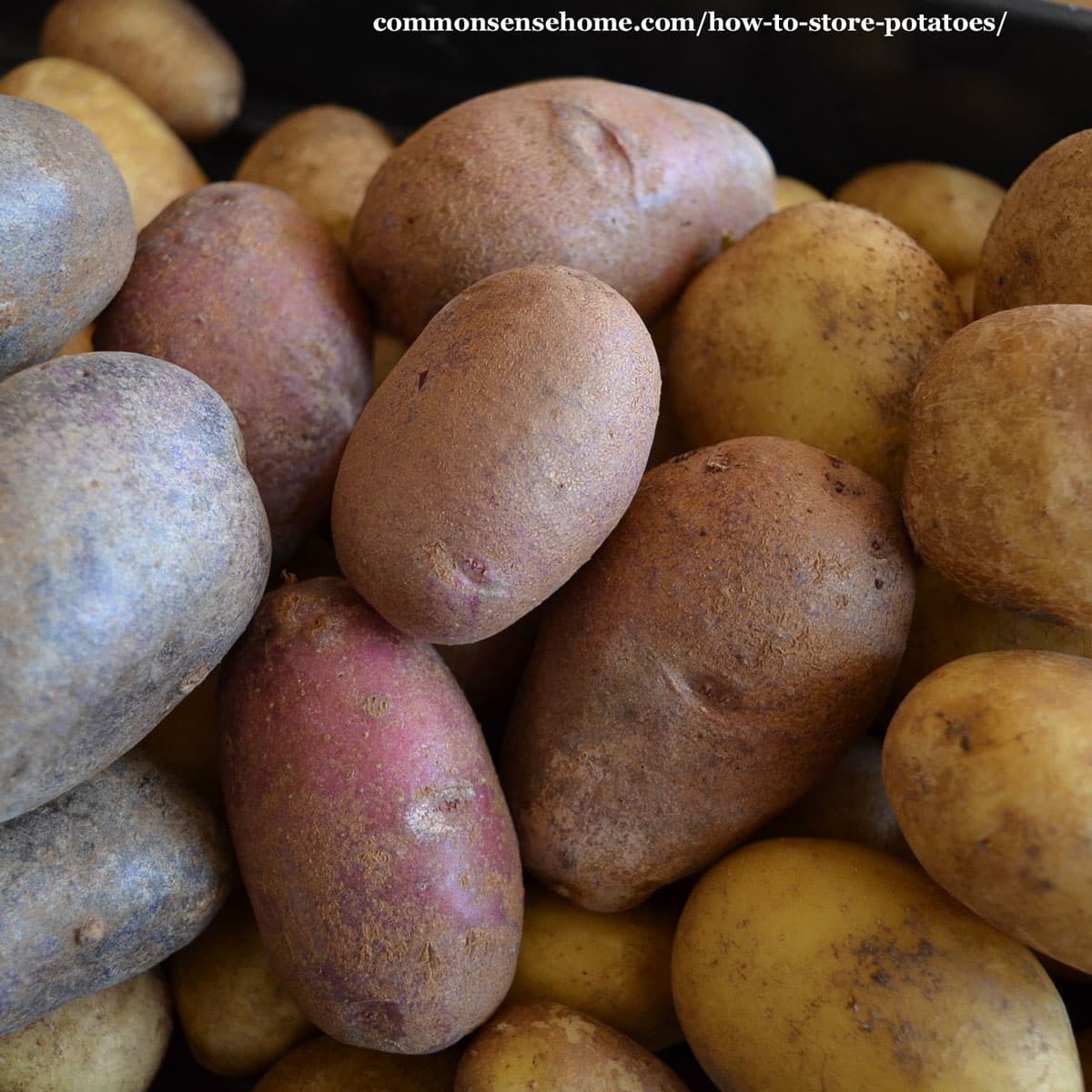
Table of contents
When to Harvest Potatoes and How to Harvest
Potatoes are ready to harvest when the tops die back. As you get closer to harvest time, avoid watering to let the skins start to toughen up.
I usually let ours hang out in the garden until we get closer to hard frost – unless we’re getting a lot of rain. If the soil is too wet, potatoes will rot, so it’s best to dig them as soon as possible.
When you’re ready to harvest, start digging to the side of the plant and carefully work your way in. Dig too close and you’re likely to stab a potato. Sort through the ground by hand to pick out the tubers. Brush off most of the dirt in the garden, and then bring them in to sort and cure.
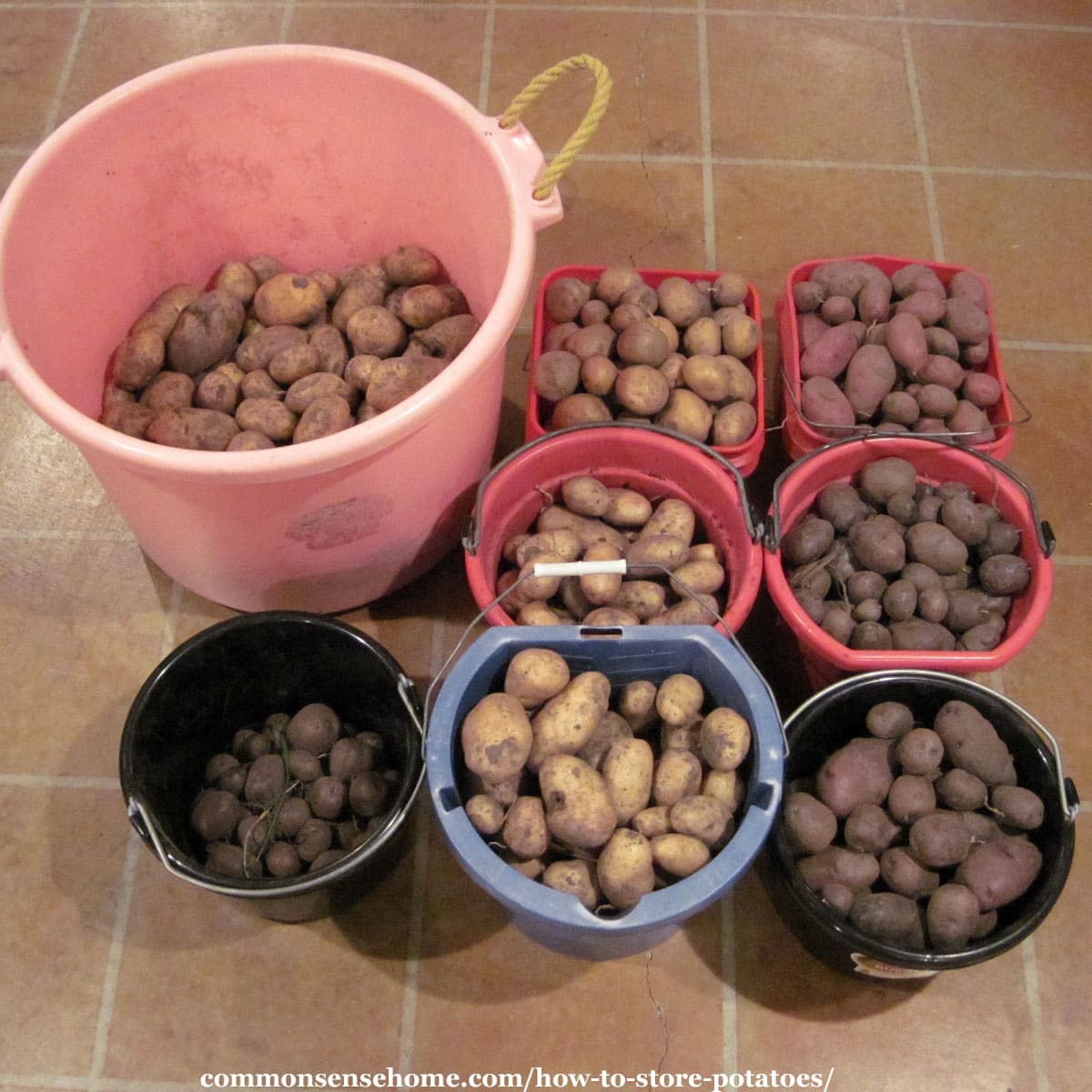
How to Cure Potatoes for Storage
To cure your potatoes, we want them cool, dry and out of the sun. Our goal is to dry them out and toughen up the skins – without them turning green from light exposure.
Spread them out in a single layer, not touching, with good air circulation. The temperature should be around 65°F ( 18°C) with no direct light. As you’re spreading them out, sort out any damaged or spoiled potatoes to use or compost immediately. Small scrapes will harden up during curing.
We place our potatoes in trays on our basement floor and cover them with burlap. You could spread them out on newspapers, or even directly on the floor.
Let the potatoes rest for 2-3 weeks, until they are well dried and the skins are toughened up for storage. If you want to, you can sort out some of the best looking spuds to save to plant for next year.
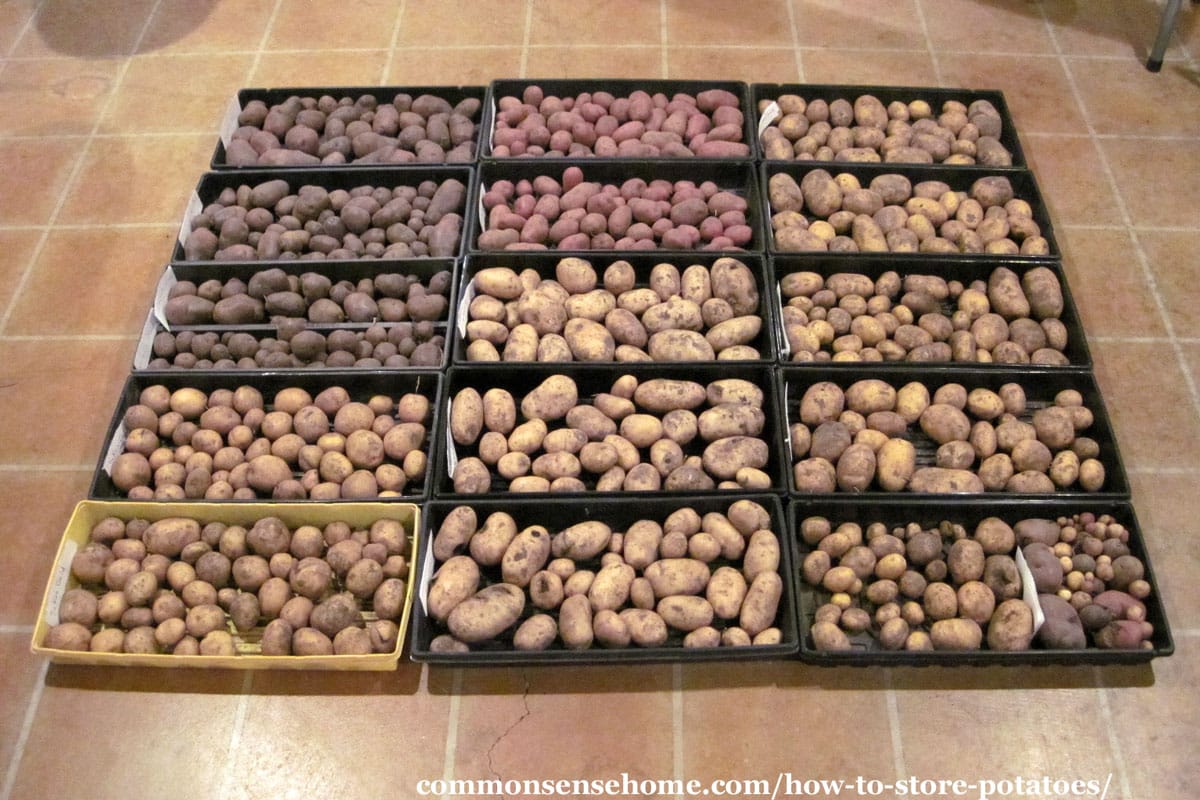
How to Store Potatoes
Once curing is done, check over the potatoes one more time. Watch out for any soft spots, as one rotten potato can spoil an entire bin. Brush off a little more dirt, if needed.
The best conditions to store potatoes long term are:
- High humidity (90% to 95%) – without humidity, your potatoes will shrivel over time.
- 45˚F to 50˚F (7˚C to 10˚C) – colder than this, and the potato starch turns to sugar, warmer and the potatoes start to sprout.
- Dark – light triggers production of chlorophyll and solanine. Solanine is bitter and can be toxic in large amounts.
- Good ventilation – potatoes and other root vegetables give off carbon dioxide and moisture in storage, so they need to breath to avoid rot.
The classic cool, dark location to stash your spuds is a root cellar. (See Root Cellars 101 for cellar building tips.)
If you don’t have a root cellar, try an unheated corner of a basement or insulated garage. See “Above Ground Root Cellars” for more locations to help your potatoes stay fresh.
Mom kept her storage potatoes in a big bin in grandma’s unheated farmhouse basement. We keep ours in a single layer trays in the root cellar, so we can quickly spot sprouts or spoilage. Some people store them in cardboard boxes, paper bags, or mesh bags.

What to Avoid When Storing Potatoes
Do NOT store potatoes in a sealed container, including plastic bags. Avoid heat, direct sun, and freezing. If your storage is too dry, the potatoes will wrinkle and get soft sooner.
We want high humidity, but not water collecting on the potatoes, which can lead to mold. Do not wash fresh dug or purchased potatoes, since this introduces extra moisture.
Do not freeze potatoes when they are fresh and raw. They will taste strangely sweet and get mushy and dark. It’s fine to freeze cooked or blanched potatoes.
What Potatoes Keep Best?
In general, russet types with thicker skins will keep best, while fingerlings and red skinned potatoes don’t keep quite as long. Late season varieties also tend to be better storage potatoes.
That said, there are a LOT of potato varieties, so if you have a favorite, try it and see how it holds up.
Would you like to save this?
The best potato for long term storage that we’ve tried to date is the Lehigh. Some other well rated varieties for storage include: Elba, Katahdin, Red Chieftain, Yukon Gold, Burbank Russet, German Butterball, Yukon Gem, Red Pontiac, All Blue, and Kennebec.

Are parts of potatoes toxic?
Shoots and spouts are mildly toxic so you should not eat them. Before you eat a stored potato, break off, or cut off sprouts or shoots. The shoots, sprouts and peels are safe to compost.
Green skin of potatoes is also mildly toxic. Peel the green skins and any green potato flesh before eating it. If a potato is very green, it’s best to compost it.
Can you store potatoes in the fridge?
We need to keep potatoes in a cool location, so why not the refrigerator? It turns out that the refrigerator is a little too chilly. (Most are set at 40˚F (4˚C) or below.) Over time, cold temperatures change your potatoes into “sweet potatoes” – and not the tasty kind.
The good news is that the process is reversible, if it hasn’t gone too far. Keep potatoes that are mildly sweet from getting too chilled at room temperature for a week or two, and the sugars will convert back to starch.
Cooked potatoes, such as mashed potatoes, will store for 3 to 5 days in the refrigerator depending on other ingredients such as: butter, bacon, sour cream etc. You can freeze cooked potatoes up to a year.

Can you store potatoes and onions together?
Onions give off ethylene gas, which causes potatoes to soften and sprout. It’s best to avoid storing potatoes and onions next to each other for long periods of time. We keep the two in different parts of the root cellar.
Many different fruits and veggies such as apples, onions, tomatoes, etc. produce ethylene gas. Without good airflow to move some of this gas out of your storage area, spoilage speeds up.
For more information on ethylene gas, see the Root Cellars 101 post.
Other Ways to Store Potatoes
You can freeze, freeze dry, and pressure can potatoes for long term storage. To freeze potatoes, you must cook or blanch the potatoes. Mashed potatoes freeze well.
Peel and chop potatoes to desired size. Cook the potatoes in boiling water until cooked through (3-5 minutes), and then scoop them out and place them in an ice bath. Drain and pat potatoes dry, and then freeze on a tray in a single layer overnight.
Pack the potatoes into freezer bags and remove excess air or vacuum seal. Store in the freezer for up to six months in standard freezer containers, a year if vacuum sealed.
To freeze dry potatoes, cook as desired, then spread on the trays and freeze dry. Keep below the recommended weight limit for your home freeze dryer. Once dry, pack for long term storage.
See the National Center for Home Food Preservation for instructions on canning potatoes.
Related Articles
- Growing Potatoes in Towers
- Potato Bread Recipe
- Grandma’s Potato Pancakes
- Long Shelf Life Foods – What Lasts Best (with Chart)
- The Easiest Vegetables to Store


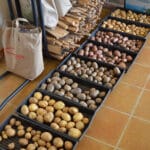
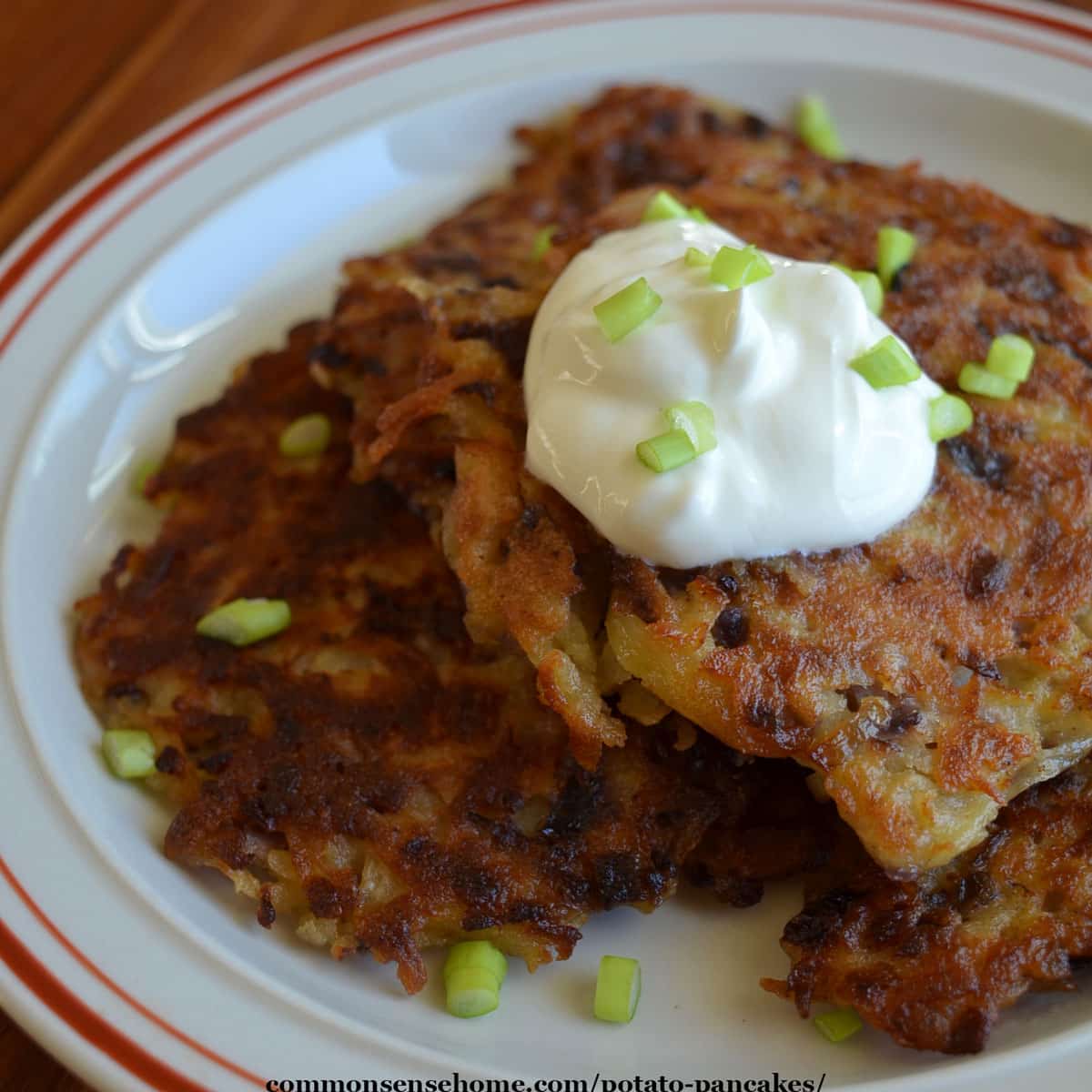
Thank you for the tips Laurie,
Much appreciated. I always use to wonder why our potatoes were most horrible when we came to the bottom of the old big thick paper sack. Do you remember buying potatoes in the 60’s when they were in those horrible sacks, sometimes tearing to reveal many different layers. You would have thought that the farmer/greengrocer would have given us some advice. The amount that we threw out at the end of the sack was most disconcerning.
Now with your tips, storing off potatoes in large amounts will be no problem whatsoever, thanks.
Incidentally Laurie, would you store carrots and parsnips in the same method?
If you end up tossing potatoes because they spoil, they sell more potatoes…
Carrots and parsnips need different care, primarily more moisture.
We generally let the parsnips overwinter in the garden under a cover of straw, and dig them in early spring, before they start growing again. This works well in our Wisconsin garden, and the spring harvested roots are sweeter. You can learn more about parsnips here.
For carrots, we dig them in fall. They’ve never held as well in the ground as parsnips do (for us). The voles in particular seem to always find the carrots, or they get mushy. I’ve tried storing them in damp sand, as some recommend, and our spoilage rates were high and it was quite messy. Storing them in fall leaves in the root cellar works fairly well. If we have a smaller harvest, we wash them and keep them in the crisper drawer of the refrigerator. You can learn more about growing and storing carrots here.
Thanks for sharing that info. Some of my sweet potatoes I have to discard because the were not in
single file.
What is the best method for storing butternut squash and others?
For squash storage information, please see, “When to Harvest Pumpkins and Other Winter Squash (and the Best Ways to Store Them)”.
Thanks for sharing, Laurie.
I have a ton of potatoes to bring in this year so helps to know how best to cure and store them.